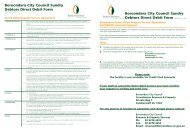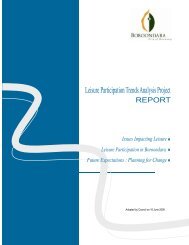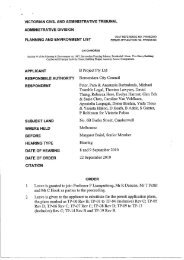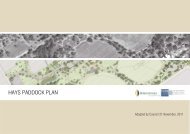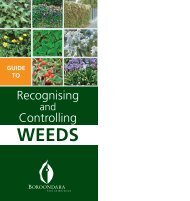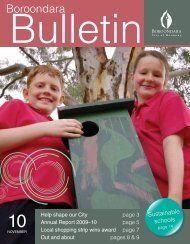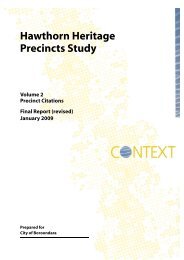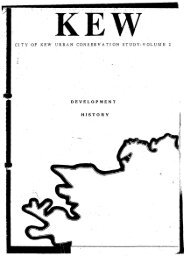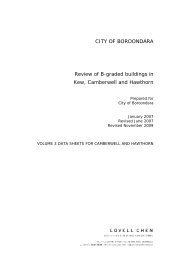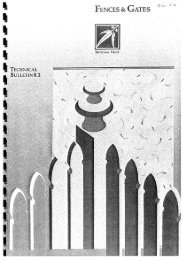Camberwell Conservation Study 1991 Vol 3 - City of Boroondara
Camberwell Conservation Study 1991 Vol 3 - City of Boroondara
Camberwell Conservation Study 1991 Vol 3 - City of Boroondara
You also want an ePaper? Increase the reach of your titles
YUMPU automatically turns print PDFs into web optimized ePapers that Google loves.
Historic Themes:<br />
Work <strong>of</strong> prominent local developer, stylistic range <strong>of</strong><br />
inter-war building.<br />
(v) typical residential lifestyles and their physical expression<br />
(x) significant persons and sites associated with them.<br />
Description<br />
Adrian Street<br />
This street has late 1920s to early 1930sstucco and brick<br />
housing, many with original fences and gardens. Styles<br />
are generally <strong>of</strong> the Old English with Mediterranean villa<br />
styles, residual Bungalows and with the Moderne style<br />
represented by Number 36.<br />
Hortense Street<br />
This street has mainly 1930s houses, with individually<br />
notable houses such as Number 6 in the Moderne style,<br />
again with many original fences and gardens and styles<br />
varyingfrom the Indian Bungalow (Number 5), to the Old<br />
English style. Other individually significant houses include<br />
32 Hortense Street which is an unusual design at<br />
the corner. Hortense Street south has some later developuiellt,<br />
but it retains the general character <strong>of</strong> the rest <strong>of</strong><br />
the street.<br />
Audrey Crescent<br />
This street has 1930sand 1940shouses, Number 28being<br />
a good example <strong>of</strong> the Moderne style. West <strong>of</strong> Florizel,<br />
there is new development, substantially unrelated to the<br />
rest <strong>of</strong> the estate.<br />
Brandon Street<br />
Some mixed redevelopment on the south, but stronger<br />
character around Aerial Avenue, where Old English<br />
style, Moderne style and original fences and gardens<br />
provide some dominant character.<br />
Celia Street<br />
This street has Camphor Laurel street trees, stucco and<br />
brick, Moderne and Old English style houses with many<br />
original fences and gardens. Frequent use <strong>of</strong> patterned<br />
brickwork, manganese, heeler brickwork and other types.<br />
Florizel Street<br />
This street has some redevelopment, but generally face<br />
brick Moderne, Old English style housing. Camphor<br />
Laurel street trees dominant, one notable house being<br />
Number 41 in the half-timbered Old English style and<br />
Number 29 showing patterned brickwork, corner siting<br />
and mature garden. Number 23 has rounded curves in<br />
the Moderne style.<br />
Significance<br />
A good example <strong>of</strong> the work <strong>of</strong> a prominent local developer,<br />
T.M. Burke. The buildings are consistent in date<br />
from the late 192Os, expressing the character <strong>of</strong> this important<br />
period in <strong>Camberwell</strong>'s development. Historically,<br />
this was the work <strong>of</strong> prominent local developer, and<br />
architecturally it shows the stylistic range <strong>of</strong> inter-war<br />
building.<br />
Important as a large and relatively intact subdivision.<br />
Summerhill Estate is also a good example <strong>of</strong> the work <strong>of</strong><br />
a prominent local developer, T.M. Burke. Burke was<br />
active in Eastern Suburbs subdivision during the 1920s<br />
<strong>Camberwell</strong> <strong>Conservation</strong> <strong>Study</strong> <strong>1991</strong>- Significant Areas<br />
and was responsible for several subdivisions in<br />
<strong>Camberwell</strong>, many <strong>of</strong> them smaller than this. The buildings<br />
are consistent in dating from the late 1920s and<br />
express the character <strong>of</strong> this important period in<br />
<strong>Camberwell</strong>'s development. Compared to nearby areas<br />
the precinct includes a better range <strong>of</strong> characteristic<br />
styles supported by period streetscape (through fences,<br />
private plantings and street trees).<br />
Themes represented. Work <strong>of</strong> prominent local developer,<br />
stylistic range <strong>of</strong> inter-War building.



